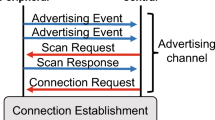Abstract
The collision avoidance and resolution multiple access (CARMA) protocol is presented and analyzed. CARMA uses a collision avoidance handshake in which the sender and receiver exchange a request to send (RTS) and a clear to send (CTS) before the sender transmits any data. CARMA is based on carrier sensing, together with collision resolution based on a deterministic tree-splitting algorithm. For analytical purposes, an upper bound is derived for the average number of steps required to resolve collisions of RTSs using the tree-splitting algorithm. This bound is then applied to the computation of the average channel utilization in a fully connected network with a large number of stations. Under light-load conditions, CARMA achieves the same average throughput as multiple access protocols based on RTS/CTS exchange and carrier sensing. It is also shown that, as the arrival rate of RTSs increases, the throughput achieved by CARMA is close to the maximum throughput that any protocol based on collision avoidance (i.e., RTS/CTS exchange) can achieve if the control packets used to acquire the floor are much smaller than the data packet trains sent by the stations. Simulation results validate the simplifying approximations made in the analytical model. Our analysis results indicate that collision resolution makes floor acquisition multiple access much more effective.
Similar content being viewed by others
References
N. Amitay, Resource auction multiple access (RAMA): Efficient method for fast resource assignment in decentralized wireless PCS, Electronic Letters 28(8) (1992) 799-801.
D. Bertsekas and R. Gallager, Data Networks, 2nd ed. (Prentice-Hall, Englewood Cliffs, NJ, 1992).
V. Bharghavan, A. Demers, S. Shenker and L. Zhang, MACAW: a media access protocol for wireless LANs, in: Proceedings of ACM SIGCOMM' 94(1994) pp. 212-225.
J.I. Capetanakis, Tree algorithm for packet broadcasting channel, IEEE Trans. Inform. Theory 25 (1979) 505-515.
C. Fullmer and J.J. Garcia-Luna-Aceves, Floor acquisition multiple access for packet-radio networks, in: Proc. ACM SIGCOMM' 95, Cambridge, MA (August 30-September 1, 1995).
C.L. Fullmer and J.J. Garcia-Luna-Aceves, Solutions to hidden terminal problems in wireless networks, in: Proc. ACM SIGCOMM' 97, Cannes, France (September 14-18, 1997).
R. Garcés and J.J. Garcia-Luna-Aceves, Floor acquisition multiple access with collision resolution, in: Proc. ACM/IEEE Mobile Computing and Networking' 96, Rye, NY (November 10-12, 1996).
P. Karn, MACA - a new channel access method for packet radio, in: ARRL/CRRL Amateur Radio 9th Computer Networking Conference(1990) pp. 134-140.
M.J. Karol and I. Chih-Lin, A protocol for fast resource assignment in wireless PCS, IEEE Trans. Vehicular Technol. 43(3) (1994) 727-732.
M.J. Karol, L. Zhao and K.Y. Eng, Distributed-queuing request update multiple access (DQRUMA) for wireless packet (ATM) networks, in: Proc. IEEE ICC' 95, Seattle, WA (June 18-21, 1995).
L. Kleinrock and F.A. Tobagi, Packet switching in radio channels: Part I - carrier sense multiple-access modes and their throughput-delay characteristics, IEEE Trans. Commun. 23(12) (1975) 1400-416.
W.F. Lo and H.T. Mouftah, Carrier sense multiple access with collision detection for radio channels, in: IEEE 13th International Communications and Energy Conference(1984) pp. 244-247.
G.S. Sidhu, R.F. Andrews and A.B. Oppenheimer, Inside AppleTalk, 2nd ed. (Addison-Wesley, Reading, MA, 1990).
F.A. Tobagi and L. Kleinrock, Packet switching in radio channels: Part II - the hidden terminal problem in carrier sense multiple-access modes and the busy-tone solution, IEEE Trans. Commun. 23(12) (1975) 1417-1433.
W. Xu and G. Campbell, A distributed queuing random access protocol for a broadcast channel, in: Proc. ACM SIGCOMM' 93, San Francisco, CA (13-17 September, 1993).
Author information
Authors and Affiliations
Rights and permissions
About this article
Cite this article
Garcés, R., Garcia–Luna–Aceves, J. Collision avoidance and resolution multiple access (CARMA). Cluster Computing 1, 197–212 (1998). https://doi.org/10.1023/A:1019089616850
Issue Date:
DOI: https://doi.org/10.1023/A:1019089616850




